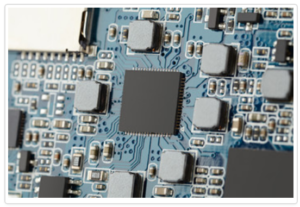
Potting compounds and encapsulation resins are generally two-part systems, in which a resin is mixed with a hardener in a precise ratio to form a cross-linked polymer when cured. It’s also possible to add mineral substances (‘fillers’) to resins to improve their performance under certain operating conditions. Like conformal coatings, most resins will cure at room temperature, and while this can be a relatively slow process in the case of potting resins, cure time can be reduced by applying heat.
An important thing to be aware of when mixing a resin with its hardener is the inevitable rise in temperature of the mix as the majority of curing reactions are exothermic in nature. The rise in temperature can be controlled by careful judgement of the amount of material that needs to be cast in a single process, as too much resin applied at once may result in components becoming overheated and possibly irreversibly damaged.
Before we get to the criteria for making a choice between potting and coating, it might interest readers to learn that, in certain applications, where a two-part resin formulation may have been the first choice for circuit protection, a two-part conformal coating may turn out to be the better approach, thanks to its superior mechanical properties, compared with one-part coatings.
For example, Electrolube has recently launched the 2K range of solvent-free coating materials, based on similar two-part chemistry to resins, but designed to be applied by selective coating equipment in the 200-400 micron range, combining many of the advantages of both technologies and minimising many of the drawbacks of each. Moreover, switching from a resin to a conformal coating will eliminate the weight penalties of the former, which may be critical to some applications.
So, how do we choose which approach is best for a particular application? Clearly, there will be applications where the choice of technology is obvious; for example, where harsh environment duty demands the highest level of protection. In this case, users can be confident that potting and encapsulation will provide the necessary long term protection, so long as the correct resin has been selected, tested and approved for the prevailing environmental conditions.
As I mentioned above, if a PCB housing provides adequate primary protection against adverse environmental conditions, then a conformal coating will protect that PCB should the primary protection fail in any way – as well as protecting against high humidity and condensation within the housing itself. And where ease and speed of processing are important, conformal coatings will always be the preferred choice, particularly as the thin cured film of a modern, well formulated coating is capable of providing a high level of protection in any case. At this point, I can’t resist coming back to the new two-part conformal coatings that I mentioned earlier, as they have rather muddied the waters as far as making that choice between potting and coating is concerned. Two-part conformal coatings can be applied relatively thickly without risk of cracking, giving a sharp edge coverage that performs somewhere between where a conventional conformal coating fails and potting is required. A two-part conformal coating’s environmental protection capability is also rather impressive.
For example, in environmental chamber trials simulating highly condensing conditions, while a urethane resin potted assembly gave the highest overall values in terms of circuit protection – and showed the least change during condensing events – the very large difference in thickness between it and a two-part conformal coating didn’t show a large increase in performance. Indeed, the two-part coating achieved much the same results as the potting compound at one tenth the thickness.
Despite these advances in conformal coating chemistries, potting and encapsulation resins will always offer the highest level of protection for PCBs, whether used to protect against mechanical shock and vibration, thermal cycling, chemical attack or the presence of high voltages where maximum dielectric strength is needed to avoid damaging discharges and leakage currents. The trade-offs are added weight, loss of rework capability, longer processing times and high cure temperatures.
If you do experience problems choosing between these methods of circuit protection, remember, there are experts out there to help. And it is always worthwhile taking the trouble to test alternative methods of protection preferably at the prototype stage before you make your final choice; the experts are ready to help you with this task as well.
By: Alistair Little

















